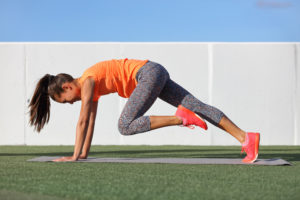
Speed is important if you play certain sports, but there’s another fitness attribute you hear less about – agility. Contrary to popular belief, speed and agility are not the same things. Speed is the ability to accelerate at a rapid rate in one direction. Think of a sprinter sprinting in a straight line.
In contrast, agility encompasses speed, but it also encompasses the ability to quickly change direction and accelerate in a different direction. A person who’s agile is “light on their feet” and quick to react. Agility is a trait that comes in handy when you play a variety of sports. Being agile is also important for reacting to things we encounter in the environment and adjusting quickly to them to avoid a fall or injury.
Unfortunately, agility training doesn’t get enough emphasis. The reality is we all need it. The good news is there are exercises you can do at home to boost your agility skills. Let’s look at some of them.
Plyometric Exercises for Boosting Agility
Plyometrics are exercises that involve stretching a muscle and then shortening it quickly. Plyo moves, as they’re called, are a good way to develop explosive power and improve vertical jump height. But certain plyometric exercises can also boost agility skills. Here are some of the best exercises that develop agility. You can do these exercises with little or no equipment. A good starting point for building agility is lateral jumps. Here’s how to do them:
Lateral Jumps
•Place a piece of tape about 3 feet long on the floor.
•Stand on one side of the tape and lower your body into a shallow squat.
•Jump laterally over the tape to the other side, landing in a squat position.
•Keep jumping laterally back and forth across the tape.
•Start with 30 seconds of alternating jumps and build up to a full minute.
Skaters
•Use the same piece of tape as a marker.
•Stand on the left side of the tape.
•Jump your right foot to the other side of the tape and cross your left foot behind the right as you descend dynamically into a lunge.
•Jump your left foot back over the line and bring your right foot behind your left.
•Keep jumping back and forth across the line in this manner.
•Move as quickly as possible and try to improve your speed over time.
This movement vaguely mimics the moves skaters do when they accelerate. Over time, this exercise will help you develop greater agility and balance.
Mountain Climbers
The mountain climber is a versatile exercise that will help you build speed and agility, and it requires little space and no equipment.
•Get into a facedown position on an exercise mat with your feet about hip-width apart. Place both hands on the mat just above your shoulders. Your body should be in a straight line, similar to a plank position.
•Flex your right hip as you raise your right thigh toward your chest. Keep your abs engaged.
•Bring your right thigh back to the starting position as you quickly bring your left thigh toward your chest in a similar manner.
•Keep switching back and forth between legs as you increase the tempo to a pace that feels like a slow run. If you’re switching legs quickly enough, both feet should leave the floor at the same time.
Medicine Ball Tosses
You will need a medicine ball for this drill, but it’s an excellent exercise to build agility in your upper body.
•Stand about 3 feet from a sturdy wall.
•Hold the medicine ball at chest level and push your arms forward to propel the ball against the wall.
•As the ball moves toward the wall, move your body laterally about 15 feet.
•When the ball comes back to you, propel it back towards the wall in the same manner.
•Keep moving back and forth between the two positions as you propel the ball towards the wall.
Shuttle Runs
Shuttle runs develop speed and agility. You can even do them in your front yard.
•Place an object you can easily pick up at a designated point on the ground.
•Place another object about 30 feet away from the first.
•Start where you placed the first object and run to the second object. Pick the object up and run back to the first object.
•Drop the second object and pick up the first one.
•Keep running back and forth as you switch objects.
•Work on improving your speed and accuracy.
Conclusion
Don’t neglect agility. It’s important for more than sports performance. We tend to lose agility as we age and doing these drills can help you preserve your body’s ability to react quickly and change directions. The ability to react quickly can save you from an injury.
Do these drills at least two times per week. You can save them for the end of a workout or even devote an entire session to agility exercises. Since these are dynamic exercises, you’ll also elevate your heart rate and build greater explosive power as well. As the exercises become easier, increase the length of time you do each one for greater cardiovascular benefits. Whatever you do, don’t neglect agility training!
References:
American Council on Exercise. “Mountain Climbers”
SportsRec.com. “How to Do Shuttle Runs”
